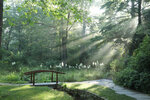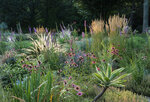If you want to get lost in a verdant labyrinth of plant life so charming and magical you may never want to come home, you don’t have to go very far.
This item is available in full to subscribers.
We have recently launched a new and improved website. To continue reading, you will need to either log into your subscriber account, or purchase a new subscription.
If you are a digital subscriber with an active subscription, then you already have an account here. Just reset your password if you've not yet logged in to your account on this new site.
If you are a current print subscriber, you can set up a free website account by clicking here.
Otherwise, click here to view your options for subscribing.
Please log in to continue |





If you want to get lost in a verdant labyrinth of plant life so charming and magical you may never want to come home, you don’t have to go very far…
Chanticleer Garden, located in Wayne, about a half-hour’s drive from Chestnut Hill, is worthy of its reputation as one of "the most romantic, imaginative, and exciting public gardens in America."
Once the country home of the Rosengarten family, this delightful spot is now celebrating its 30th year as a public garden – one of 38 public gardens within a 30-mile radius of Philadelphia.
In that time, it has been transformed into the masterpiece it is today. Here, a creative team of seven horticulturists has complete artistic freedom over the design and maintenance of the areas that they tend – and it shows. Each distinct part of this garden has a personality all its own.
In Chanticleer, a Pleasure Garden, garden writer Adrian Higgins writes that one of the things he likes best is that "it doesn't have an agenda. It isn't, for example, only native plants. It doesn't label everything, like an arboretum. It's about plants; plants on their stage.”
"It's music, it's ballet, it's cinema, the garden as an art form," he writes.
The garden also boasts its own woodshop and metal shop, where staff makes everything from benches to bridges – resulting in an array of installations that can truly be considered works of art. The result is an environment that seems more than a little tinged by a fairy tale.
All this happens with an eye toward supporting the natural world. Chanticleer gets 20 percent of its electricity from on-site solar panels, and cisterns capture a staggering 50,000 gallons of rainwater for irrigation. Integrated pest management means a minimal reliance on pesticides, and lawns have given way to meadows and sedges, providing habitat.
“Chanticleer is an experimental garden, where we protect the environment as we experiment with different plants, and keep our displays constantly changing,” said Erin Dougherty, Chanticleer’s Public Program Manager. “As a public garden, our goal is to make gardening more accessible to everyone – and encourage our visitors to try out new methods and techniques at home.”
While all of Chanticleer is magical, there are some particularly popular attractions that should not be missed. The Ruin Garden, built on the footprint of what was once Adolph, Jr., the founder’s house features enchanting water features and whimsically placed treasures of green growing things, peeking out of crevices and corners. It’s a display of nature at work, reclaiming what was made by man.
Next is the Pond Garden, where turtles plunk in and out of the water and the brightly colored koi swim right up to you – a particular favorite for families. July, when the lotuses are in bloom, is a particularly great month for this delightful spot.
Then there’s the Chanticleer Terrace overlook, designed by landscape architect Thomas Sears to seamlessly extend the essence of the house into the garden. Here, you can relax in the shade of an enormous silver Linden tree, catching the breeze as it crests the hill while you take in the expansive view of the valley below. This spot has the added benefit of being easily accessible – a good choice for those who may not want to take the 1-mile walk around the grounds.
The garden remains open until 8 p.m. on Friday evenings from May through Labor Day and allows guests to bring a picnic and pick their favorite garden spot. (Typically, picnics are allowed only in designated picnicking areas.) Due to their popularity, securing a parking reservation in advance is essential on these nights.
Guided tours of the house are available on Fridays and Saturdays at 11 a.m. and offer a glimpse into the rich history of not just the family, but of Main Line life during the years that the Rosengartens lived there.
The family history
The Chanticleer estate dates from the early 20th century, when the land along the Main Line of the Pennsylvania Railroad was developed for summer homes to escape the heat of Philadelphia.
Adolph Rosengarten, Sr., and his wife Christine, whose family pharmaceutical firm was deeply rooted in Philadelphia's social and industrial history, chose this spot for their summer home. It was in this tranquil retreat that the Rosengartens found solace away from the bustling city. Architect Charles L. Borie designed the house, which was completed in 1913, and landscape architect Thomas Sears designed the terraces as extensions of the house.
Adolph and Christine gave their two children homes as wedding presents, and in 1933 purchased a neighboring property for son Adolph, Jr. and his bride Janet Newlin, who was originally from Chestnut Hill. That property is now the site of the Ruin Garden, which is one of Chanticleer’s most popular attractions. Daughter Emily's house, located at today's visitor entrance, was built for her in 1935. It is presently used for offices and classrooms.
The family's prominence dates back to the mid-19th century when George David Rosengarten, an immigrant from Germany, co-founded the successful pharmaceutical company, Powers & Weightman, later known as Rosengarten and Sons – which would eventually become part of Merck & Company.
Their story embodies the spirit of entrepreneurship and innovation that drove the industrial strength of turn-of-the-century Philadelphia. With their scientific expertise and business acumen, the Rosengartens helped to pioneer the large-scale production of important drugs, including quinine, a treatment for malaria.
In addition to their success in business, the Rosengartens were recognized for their commitment to the welfare of their employees and the community. Upon the death of Adolph Jr., in 1993, the estate bequeathed the family’s beloved country home to the Chanticleer Foundation to operate as a public garden.
“Adolph, Jr.’s bequest was a selfless act,” said Dougherty. “His desire was for gardeners of every level to find joy wandering the grounds, and to see his family’s legacy carried on.”
For the committed gardener:
In addition to being a wonderful place to visit, Chanticleer is also an educational resource for home gardeners. Evening classes cater to enthusiasts eager to expand their knowledge and hone their skills. This summer's offerings encompass a diverse range of topics, from deer-resistant gardening to designing and planting for challenging garden sites. Insect and pollinator identification classes provide invaluable insights into the delicate ecosystems that thrive within Chanticleer's borders.
Chanticleer also offers workshops tailored for advanced gardeners, where participants can learn skills used by the horticulturists themselves. A two-day gardening workshop in late June explores the intricacies of planting succession, staking, and flower arranging, while a four-day garden design workshop led by acclaimed British garden designer Annie Guilfoyle is scheduled for July.